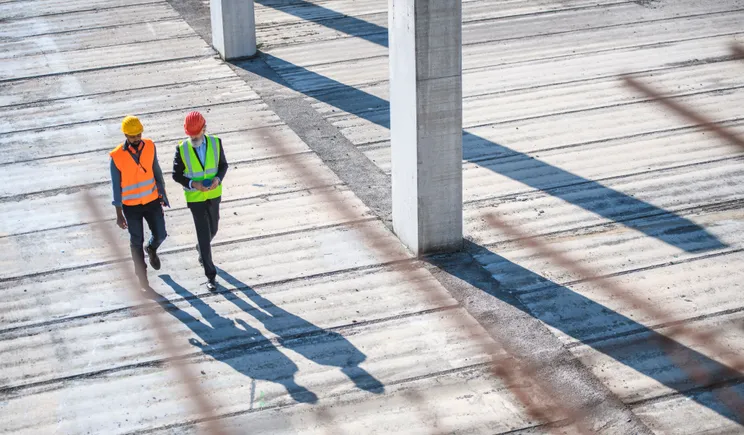Just by moving the location of a parking lot, an Aecon vice president says his team shaved more than 1,000 hours of wasted time off a recent, high-profile job.
On the Gordie Howe Bridge project connecting Detroit to Ontario, Eric Lusis, vice president of continuous improvement for Toronto-based Aecon, said he observed the location of a workers’ parking lot in relation to the jobsite. The long walk from the lot ate up time, so the project team moved it, changing it from a four-minute walk to a one-minute walk.
On average, that meant each worker saved six minutes a day going to and from their cars. For 100 team members across 160 work days, Lusis estimated Aecon saved 1,600 hours that would’ve been spent traversing the site.
“Just stopping and observing can be impactful,” he said.
Lusis noticed the inefficiency during a gemba walk, a lean construction practice designed to help contractors see in person how work is being performed, identify challenges, notice inefficiencies and develop better communication.
The actual place
Gemba (also spelled genba) is a Japanese term meaning “the actual place.” The name refers to physically visiting jobsites and being present during a walkaround. The practice was pioneered by manufacturing leaders at Toyota.
It also means to be deliberate, focusing on everything happening together and identifying how to improve, Lusis said during a recent Lean Construction Institute webinar.
“In the field, sometimes that can be a hard thing to do,” he said, acknowledging that superintendents or project managers may not always have the time to stop and observe work.
The LCI offers suggestions for how to perform a gemba walk, including:
- Plan ahead. Consider questions to ask ahead of time and write them out to ensure they’re varied. Inform the team you’re coming, and tell them what a gemba walk is so you don’t interrupt their workflow.
- Analyze the process, not the people. A gemba walk is not the time to critique workers on their productivity, rather for determining the efficiency of the process itself.
- Go with the flow. Follow the value stream in sequential order. Doing so will make finding waste easier. Take team members with you and talk to them as you observe.
- Follow up. Return for a follow-up walk after giving the team time to try the changes.
Forming the right questions
LCI recommends not asking yes-or-no inquiries. Instead, managers can use productive questions starting with “what,” “why,” or “how?”
“It’s asking questions like, ‘Your plan of the day says this, why did you change?’” said Tammy McConaughy, LCI director of education and certification. “‘What’s in your way today? How are you going to achieve this?’”
During a gemba walk, managers ask questions to learn more about issues impacting productivity on the jobsite.
Sean Anthony Eddy via Getty Images
Another way of thinking about it is to go see what work is planned for the day vs. what work is actually happening, then trying to connect the dots between the two, according to McConaughy.
And it’s important to come to the jobsite with an open mind, not looking to point fingers, but rather to build a rapport with the folks on the job to better understand the obstacles creating inefficiencies, McConaughy told Construction Dive.
“A lot of times, if you think about it as a GC, when you ask a trade foreman a lot of questions, they get really uptight. ‘What did I do wrong? Why all these questions?’” she said. Practicing asking questions from a humble place of learning and actively listening to those on the jobsite can be a key step to building that rapport, and sticking to an efficient schedule.
Other benefits
And it’s not just on the jobsite. McConaughy said she has seen contractors find and fix inefficiencies in the office around practices such as mailing important packages or documents.
It can also work with safety. During the height of the COVID-19 pandemic, McConaughy said she knew of companies whose leaders would walk the jobsite and see individuals with masks but no safety goggles or vice versa, because working with both caused the glasses to fog up.
Rather than simply saying, “put on your darn glasses,” McConaughy said that the approach around safety in a gemba walk would be to ensure those observing know why the craftworkers aren’t following protocol, and how to make it easier to keep workers safe.
She said the company tried different masks, other eye protection and anti-fog wipes, but the biggest benefit was that it led to discussions with the safety lead and foreman to understand the right solution for crews. That meant different solutions for different work, such as indoor or outdoor or various weather conditions.
Isn’t it obvious?
Going to the jobsite to observe work can seem like a pretty obvious way of solving problems, and McConaughy said a gemba walk is a “deceptively easy” method of doing so.
“This is such a reactive industry,” she said, saying too often problems come up and are immediately solved with the fastest solution as opposed to the best. She used the imagery of a superintendent storming out of a jobsite trailer and encouraged a different approach.
“Instead of going, ‘We’re behind schedule I’m going out there because I know everyone is screwing up,’ maybe saying, ‘We’re supposed to be doing this today, I’m going out there to figure out what is happening, what’s not happening and why,’” she said.

